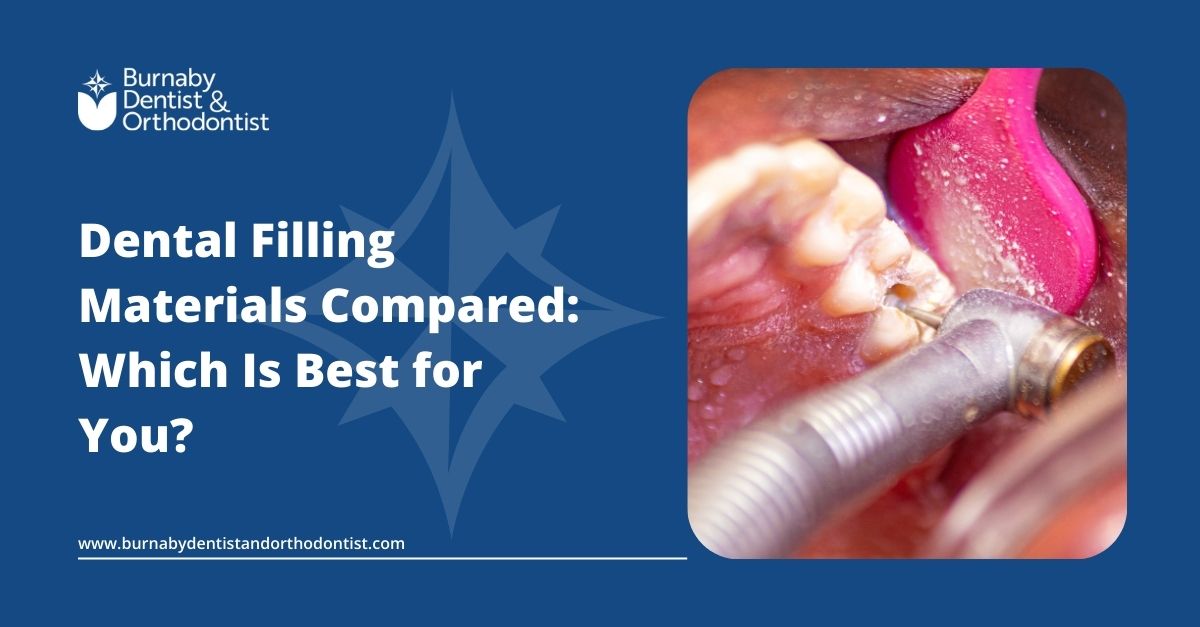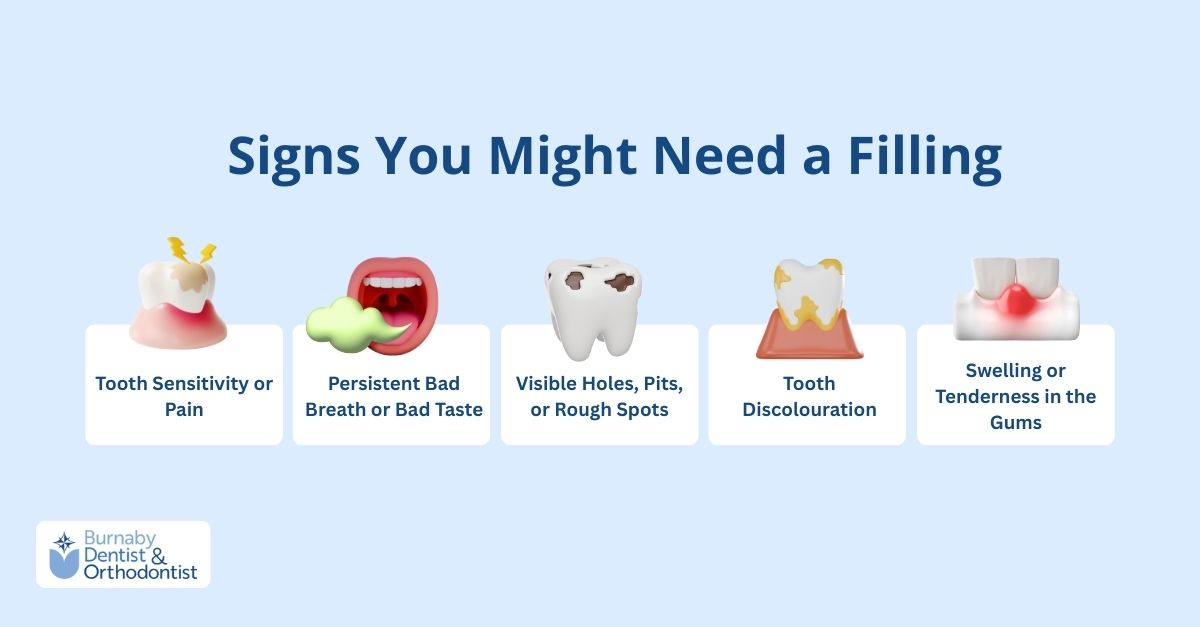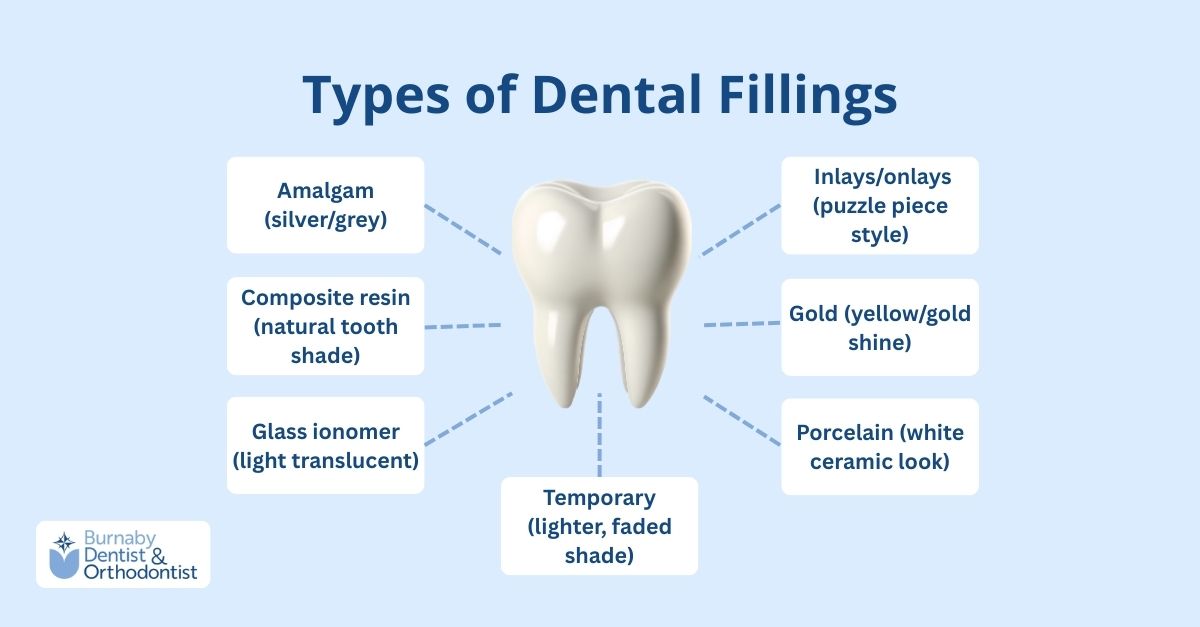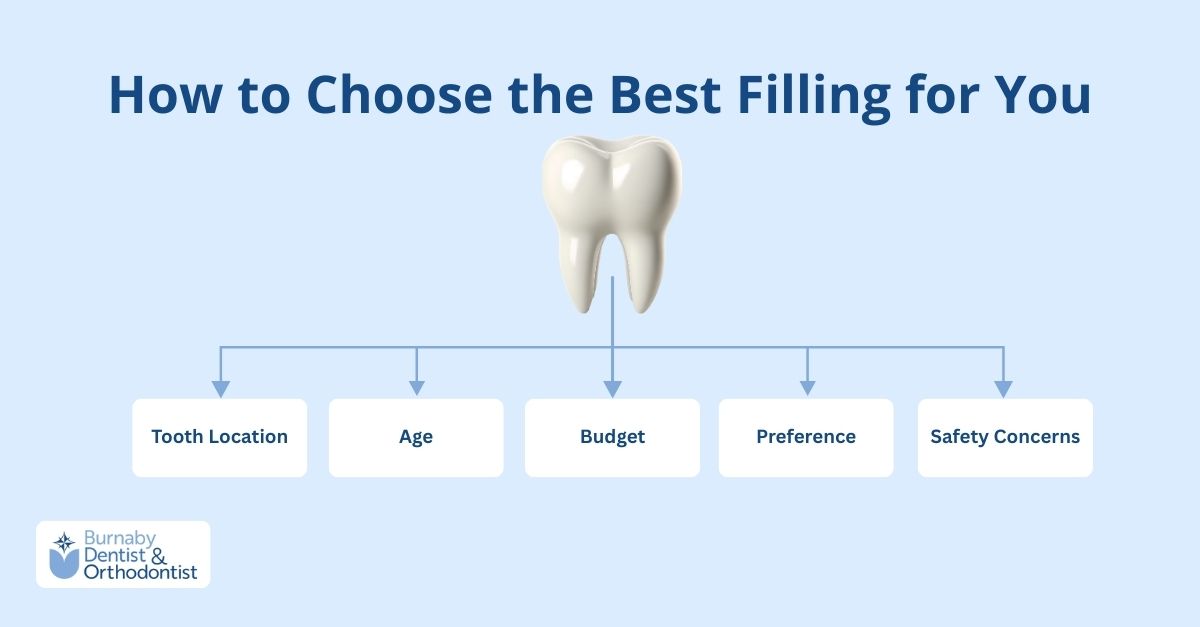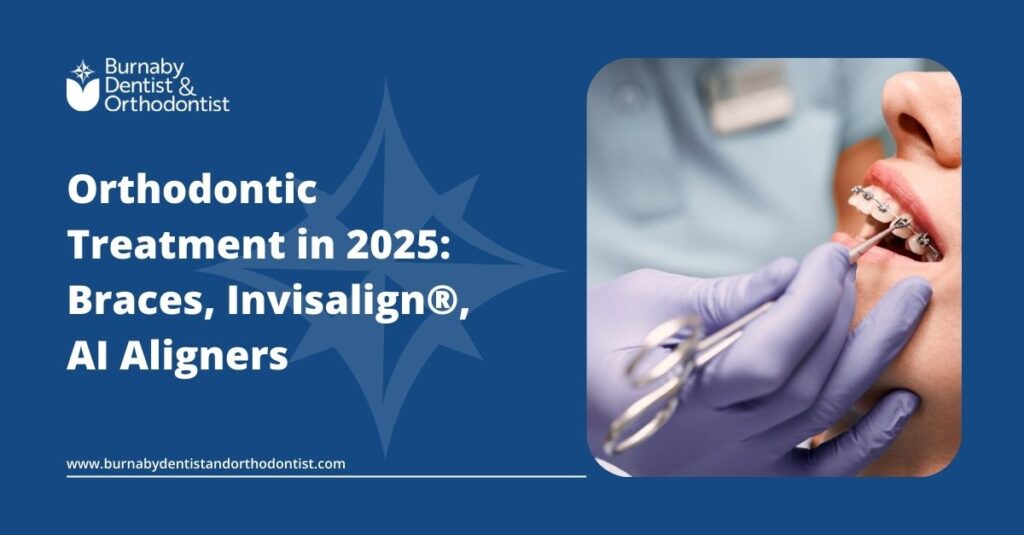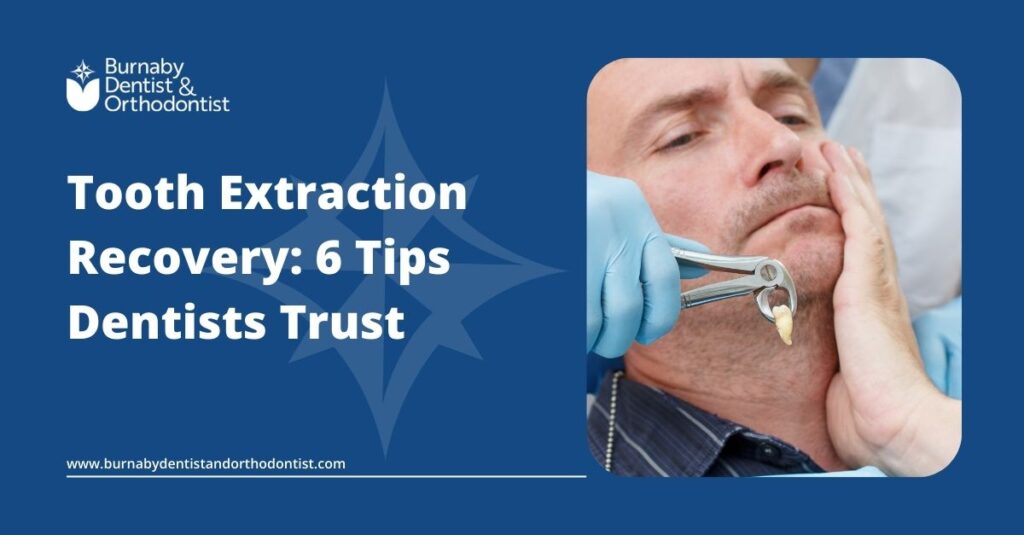Need a dental filling? You’re not alone—and you’ve got more choices than ever.
Fillings don’t just patch up cavities. They restore your tooth’s strength, protect against future damage, and affect how your smile looks and feels. That’s why choosing the right material matters.
Some fillings are built for durability. Others blend naturally with your tooth colour. Cost, longevity, and comfort all come into play—and no single option is best for everyone.
At Burnaby Dentist & Orthodontist, we guide patients across Burnaby—from Metrotown to Brentwood—through their options with clear, personalized advice.
In this guide, you’ll discover the most common types of filling materials, their pros and cons, and how to choose the one that fits your needs best.

At Burnaby Clinic Begin Your Smile Journey With Dr. Sasan Hadianfar
What are dental fillings?
Dental fillings are one of the most common treatments in dentistry, but they play a very important role. Simply put, a filling is used to restore a tooth that has been damaged by decay, wear, or minor cracks.
By filling in the affected area, your dentist prevents the problem from spreading while also restoring the tooth’s normal function and shape.
You might also hear fillings referred to as tooth fillings, cavity fillings and dental restorations (a broader term that also includes inlays, onlays, bridges, and crowns).
Think of a filling as a protective patch for your tooth. Once placed, it seals off vulnerable areas, making it easier to chew comfortably, keep your smile healthy, and avoid bigger treatments down the road.
Your dentist will walk you through the different material options available and help determine which type of filling is best suited for your tooth and your lifestyle.
The Benefits of Dental Fillings
Dental fillings aren’t just about fixing a cavity, they’re about protecting and strengthening your teeth for the long run. Here are some of the key ways they benefit your oral health:
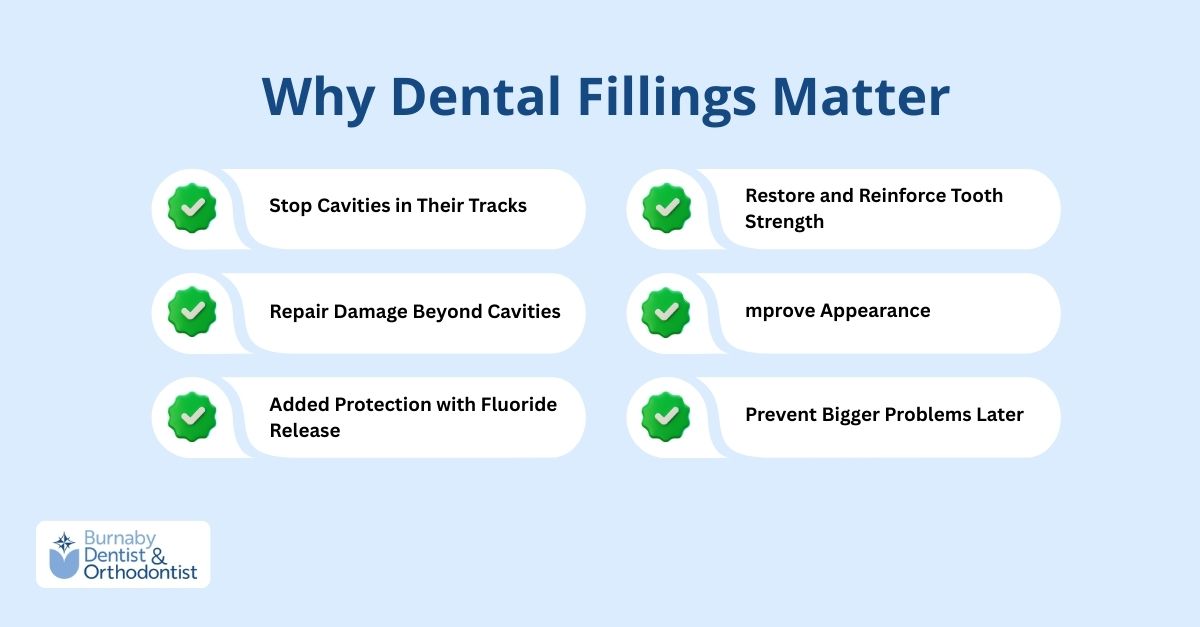
Stop Cavities in Their Tracks
When a filling is placed, the decay is cleaned out and sealed off. This prevents the cavity from spreading deeper into the tooth and reduces the chance of new decay forming in that same spot.
Restore and Reinforce Tooth Strength
Decay weakens teeth, making them more prone to chips and cracks. A filling restores the lost structure, giving the tooth back its stability so it can handle everyday biting and chewing without further damage.
Repair Damage Beyond Cavities
Fillings aren’t only for tooth decay. They can also be used to fix minor chips, breaks, or wear caused by grinding (bruxism), helping your tooth regain both its function and its natural look.
Improve Appearance
Modern fillings can be made to match the shade of your natural teeth, blending seamlessly with your smile. In some cases, they can even reshape front teeth for a more polished appearance.
Added Protection with Fluoride Release
Certain filling materials slowly release fluoride, which helps strengthen the surrounding tooth and guard against future decay by discouraging bacterial growth.
Prevent Bigger Problems Later
By treating tooth decay early with a filling, you often avoid more invasive and costly procedures, like crowns or root canals, down the road.
Signs You Might Need a Filling
Cavities can creep up slowly, but the earlier you recognize the signs, the easier they are to treat. Here are the most common symptoms that may indicate you need a filling:
- Tooth Sensitivity or Pain: Sharp or lingering discomfort when eating or drinking something hot, cold, or sweet; persistent toothaches may signal deeper decay.
- Persistent Bad Breath or Bad Taste: Bacteria trapped in a cavity can cause halitosis or an unpleasant taste that brushing and mouthwash don’t fix.
- Visible Holes, Pits, or Rough Spots: Small cavities or cracks may look like dark spots or feel uneven when you run your tongue across your teeth.
- Tooth Discolouration: Yellow, brown, or grey patches on your teeth can be an early sign of decay rather than just surface staining.
- Swelling or Tenderness in the Gums: Localized redness or puffiness near a tooth can indicate infection from untreated decay spreading deeper.
Types of Dental Fillings
Dental fillings fall into two broad categories: direct and indirect. Direct fillings are placed directly into a prepared tooth in a single appointment, while indirect fillings are custom-made outside the mouth (in a dental lab or with CAD/CAM technology) and then fitted to the tooth, usually requiring two visits.
Amalgam (Silver Fillings)
Amalgam fillings—made from a blend of silver, copper, tin, and mercury—were once the go-to material for restoring molars due to their strength and durability. However, they are dark in colour and more noticeable in the mouth, which has led many patients to prefer tooth-coloured alternatives.
At Burnaby Dentist & Orthodontist, we no longer place amalgam fillings. Our clinic focuses exclusively on modern, mercury-free materials that are safer, more aesthetic, and better aligned with today’s dental standards.
We believe in preserving natural tooth structure whenever possible and using biocompatible options that prioritize both function and appearance. If you have existing amalgam fillings, we’re happy to evaluate their condition and discuss replacement options if needed.
Composite Resin (Tooth-Coloured Fillings)
Composite fillings are made from a blend of plastic resin and fine glass particles, bonded directly to your tooth. They’re custom-shaded to match your natural enamel, making them an excellent choice for visible areas—especially front teeth.
In addition to their aesthetic appeal, composite fillings require less removal of healthy tooth structure compared to older materials. This allows for a more conservative and tooth-preserving restoration.
While composites are durable and highly effective for small to medium-sized cavities, they may wear more quickly in areas exposed to heavy chewing forces. On average, they last 5 to 10 years with proper care.
They can also stain over time from coffee, tea, or tobacco. However, for patients who prioritize a natural look and metal-free restorations, composite fillings remain the most popular option.
Glass Ionomer Fillings
Glass ionomer is a tooth-coloured material made from a specialized glass powder. It chemically bonds to the tooth and has the added benefit of slowly releasing fluoride, which helps strengthen the tooth and protect against future decay.
However, glass ionomer is not as strong as other filling materials and is generally used in specific situations, such as for temporary fillings, children’s teeth, small cavities, or non-biting surfaces.
Dentists may also use it for fissure sealant, where the material helps protect deep grooves in the back teeth from decay.
Inlays and Onlays
When damage to a tooth is too extensive for a standard filling but not severe enough to require a full crown, dentists often recommend inlays or onlays. These are indirect restorations that fit into or over the tooth like a puzzle piece, restoring its shape, strength, and function.
They are custom-made in a dental lab and can be created from gold, porcelain, or composite materials. Inlays fit within the biting surface of the tooth, while onlays extend over the edges to provide more coverage.
Gold Fillings
Gold fillings are among the most durable and long-lasting options, often lasting twenty years or more. They are made from gold combined with other metals like silver, tin, or palladium and are well-tolerated by gum tissues.
Gold is resistant to wear and provides excellent strength, making it an ideal choice for molars and other heavily used teeth.
However, gold fillings require at least two appointments to complete, are more visible in the mouth, and are typically the most expensive option.
Porcelain (Ceramic) Fillings
Porcelain fillings, also known as ceramic restorations, are tooth-coloured and custom-made to match the surrounding teeth.
They are highly aesthetic and resistant to staining, which makes them an excellent choice for patients seeking a natural look.
Like gold, they are usually made in a dental lab and bonded to the tooth in a second appointment, although CAD/CAM technology can sometimes allow for same-day placement.
While porcelain is strong, it can be more brittle than gold, especially if used in thin sections, and its cost is often similar to that of gold restorations.
Temporary Fillings
In some cases, a dentist may place a temporary filling rather than a permanent one. This can happen if treatment requires multiple visits, if an emergency filling is needed, if there is not enough time to complete a procedure in one appointment, or if a tooth is undergoing root canal treatment and needs protection in between stages.
Temporary fillings are designed to be replaced later with a permanent restoration once treatment is completed.
Which type is best?
There’s no one-size-fits-all answer when it comes to dental fillings. The ideal material depends on several factors—like the location and size of the cavity, how visible the tooth is when you smile, your budget, and whether you prioritize long-term durability or a seamless, natural look.
Your overall health also matters. For example, patients with allergies, sensitivities, or certain medical conditions may benefit from specific biocompatible materials.
At Burnaby Dentist & Orthodontist, we take the time to understand your unique needs before recommending a filling. Whether you want something discreet for a front tooth or something strong for a back molar, we’ll help you choose the option that works best for your comfort, health, and lifestyle.
How to Choose the Best Filling for You
With so many options available, the best dental filling isn’t the same for everyone. The right choice depends on a mix of practical and personal factors. Here are some of the key considerations your dentist will walk you through:
Tooth Location
Where the filling is placed in your mouth makes a big difference. Back teeth (molars) handle the most chewing pressure, so stronger materials like amalgam, gold, or porcelain are often recommended.
For front teeth, which are more visible when you smile, tooth-coloured options like composite resin or porcelain are usually preferred for their natural appearance.
Age
Children and adults often need different approaches. For younger patients, especially those with baby teeth, glass ionomer fillings are sometimes used because they release fluoride and provide protection against further decay, even if they aren’t as strong long term.
Adults, on the other hand, usually benefit from more durable materials that can handle years of wear.
Budget
Cost and insurance coverage can also guide the decision. Amalgam and composite fillings are generally more affordable, while gold and porcelain restorations are more expensive and may not always be fully covered by insurance. Your dentist can help you weigh the upfront cost against the long-term durability of each option.
Preference
Some people care most about durability, while others prioritize a natural look. If appearance is a top concern, composite resin or porcelain fillings will blend in seamlessly with your smile.
If strength and longevity matter more, gold or amalgam may be better choices, particularly for back teeth that aren’t as visible.
Safety Concerns
For patients who want to avoid mercury-containing materials, mercury-free options such as composite resin, glass ionomer, porcelain, or gold are available.
Your dentist will also consider medical conditions or special circumstances, such as pregnancy, when recommending the safest option for you.
Risks of Delaying Treatment
It can be tempting to put off getting a filling, especially if the tooth isn’t causing much pain yet. But cavities don’t heal on their own, they only get worse over time. What may start as a small, simple filling can quickly turn into a bigger dental problem.
When decay spreads deeper into the tooth, it can reach the inner nerve, leading to infection and the need for a root canal or even a crown to restore the tooth. In some cases, waiting too long can result in damage so severe that the tooth can’t be saved at all.
Delaying treatment also means higher costs and more discomfort. A filling is a quick and relatively inexpensive procedure, but root canals, crowns, or extractions are more complex, take more time, and are much harder on both your mouth and your wallet.
Addressing cavities early with a filling not only protects your tooth structure but also helps you avoid unnecessary pain and expenses in the future.
Conclusion
When it comes to dental fillings, there isn’t a single material that’s best for everyone. The right choice depends on where the cavity is, how much durability you need, your budget, and your personal preferences for appearance and safety.
What matters most is treating decay early, before it has a chance to turn into something more serious.
By understanding the pros and cons of each filling material, you can make an informed decision with your dentist and feel confident about your treatment. A well-chosen filling not only restores your tooth but also protects your smile and helps you avoid more complex procedures down the road.
If you think you may need a filling or want to discuss which option is right for you, our team at Burnaby Dentist & Orthodontist is here to help.
We’ll guide you through your choices, answer your questions, and make sure your treatment keeps both your smile and your overall oral health in the best shape possible.
Don’t wait until it gets worse. Book your dental filling consultation with Burnaby Dentist & Orthodontist today and protect your smile with the treatment that’s right for you.

